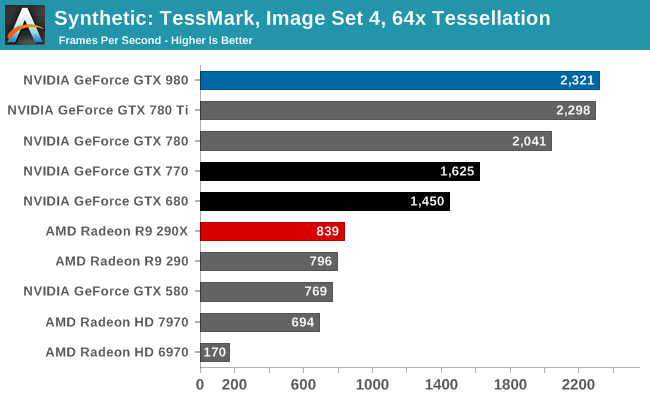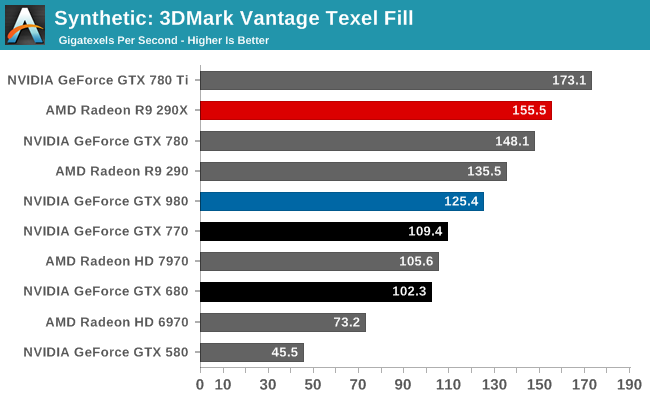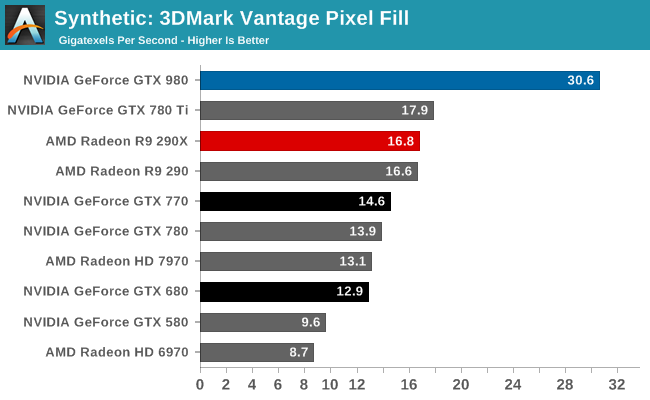The NVIDIA GeForce GTX 980 Review: Maxwell Mark 2
by Ryan Smith on September 18, 2014 10:30 PM ESTSynthetics
As always we’ll also take a quick look at synthetic performance. These tests mainly serve as a canary for finding important architectural changes, and with the exception of pixel throughput we are not expecting any major changes for GTX 980 and GM204.

GM204 is designed to have an ever-so-slightly higher triangle throughput rate than GK110 – 16 tris/clock versus 15 tris/clock, and sure enough the GTX 980 comes out on top in TessMark, slightly edging out the GTX 780 Ti. The difference is only very slight here, and though GM204 should be a bit more powerful than GK110 in practice it’s a dead heat.
Moving on, we have our 3DMark Vantage texture and pixel fillrate tests, which present our cards with massive amounts of texturing and color blending work. These aren’t results we suggest comparing across different vendors, but they’re good for tracking improvements and changes within a single product family.

Beginning with Maxwell NVIDIA reduced their texture-to-compute ratio from 12:1 to 16:1. As a result of this change Maxwell GPUs have fewer texture units than comparable Kepler GPUs. Compounding this effect is the fact that Maxwell CUDA cores are more efficient than Kepler CUDA cores, leading to NVIDIA placing fewer cores overall and further reducing the texture fill rate.
As a result the GTX 980 is not texture fillrate competitive with any of the GK110 cards. It is competitive with the GK104 cards, but only because these cards had the same number of texture units at 128. NVIDIA has told us that they believe this new ratio is a better fit for modern workloads, and judging from the performance we’re seeing elsewhere it would appear that NVIDIA is right.

On the other hand, thanks to NVIDIA’s newer 3rd generation delta color compression technology, our 3DMark pixel fillrate performance is through the roof. GTX 980 comes very close to doubling the throughput of our GK110 cards and more than doubles the throughput of the GK104 cards, reflecting the fact that it has 64 ROPs and more importantly has the available bandwidth to put them to good use.
This benchmark in a nutshell is why NVIDIA can deliver chart-topping performance despite having only 2/3rds the memory bandwidth of GTX 780 Ti. By improving their color compression to this point, NVIDIA can significantly reduce their memory bandwidth requirements Maxwell 2, allowing them to do more with less. In real games the result won’t be anywhere near this remarkable since this is a pure pixel fillrate test, but it goes to show that NVIDIA has been able to expand their effective memory bandwidth in concert with their ROP and shader performance improvements.










274 Comments
View All Comments
Dribble - Friday, September 19, 2014 - link
Looks at prominently placed "AMD CENTRE" link at top of page.wolfman3k5 - Friday, September 19, 2014 - link
Don't forget, this is a prominent pro Intel/NVIDIA site. What did you expect?!Samus - Friday, September 19, 2014 - link
That's because everything AMD touches is a joke. ATI was at the top of their game, far ahead of NVidia on price:performance, then AMD buys them. Look where ATI's been at since. GCN is a crappy architecture. The Netburst of GPU's. Ridiculously high power consumption. The only corner market is has is FP64. If you actually game, GCN is a dud. The only reason Sony/Microsoft went with AMD GPU's was because it's the best (only) integrated CPU/GPU solution (something NVidia has no IP) other than Intel which is way too expensive for consoles and still not as good.bwat47 - Friday, September 19, 2014 - link
Until maxwell AMD's gpu's were handily outperfoming nvidia when it came to price/performance. GCN isn't a bad architecture, its just outdated compared to nvidia's brand new one. I'm sure AMD has architecture improvements coming down the road too. This happens all the time with nvidia and AMD where one of them leapfrogs the other in architecture, the cycle will continue. Right now nvidia is ahead with maxwell, but acting like AMD is doomed or saying that their architecture is the 'netburst of gpu's is silly.Laststop311 - Sunday, September 21, 2014 - link
AMD is going to have to perform a miracle to get their performance and energy use close to nvidia. AMD may keep up in performance but they are going to do that with a 300+ watt dual 8 pin required + liquid cooling required or triple slot required cause it's going to hog the power to keep up and surpass nvidia. Nvidia's solution is much more elegant and there is little hope for amd to match thatLaststop311 - Sunday, September 21, 2014 - link
This isnt even counting gm210. When big maxwell drops at 20nm I just don't see how amd will be able to match it. Like I said it will take an engineering miracle from amdYojimbo - Friday, September 19, 2014 - link
There's a difference between bias and impression. At what point does what you call "tempering bias" become a source of bias in and of itself, because one cannot give one's impression? For instance, the removal of branding the R290X reference card "loud" (which it is). I encourage Mr. Smith neither to "temper his bias" nor to get involved in the "ongoing battle between Nvidia and AMD GPUs", and instead to report the facts and relay his honest impression of these facts. If he does this well, I think the majority of readers of this site will support him for attempting to give a real representation of the state of the products available, which is what they are presumably looking for.wolfman3k5 - Friday, September 19, 2014 - link
Looks like these GTX 970 and 980 cards are shit when it comes to compute, especially double precision floating point operations. I don't game, so I don't care about FPS. I do more productive things with video cards though.Laststop311 - Friday, September 19, 2014 - link
than maybe you should buy a workstation card and not a gaming card or at the very least a titan if you cant afford the super outrageously priced quadro's and tesla'sNfarce - Sunday, September 21, 2014 - link
Then you simply aren't the target market for these types of cards. Like Lastop311 said...go bend over for a professional level workstation GPU that most people here care nothing about. :-/